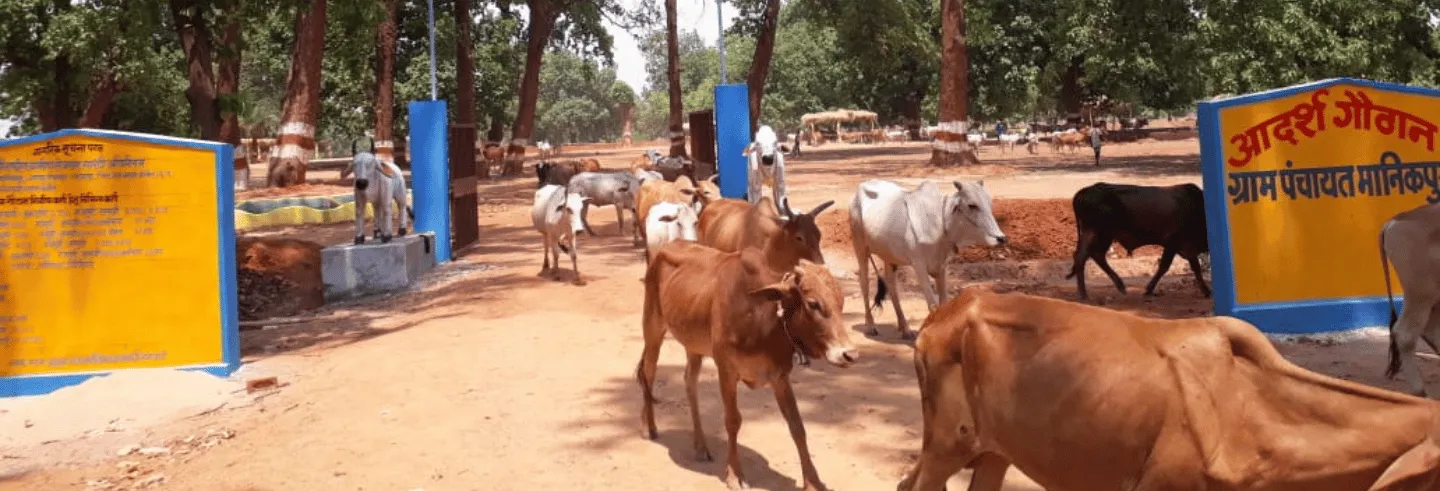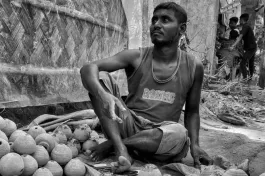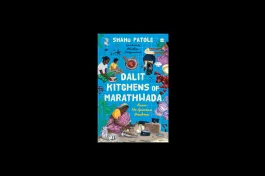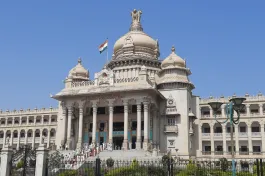In August 2024, the Congress party in Chhattisgarh undertook a state-wide Gau Satyagraha to protest the growing numbers of stray cattle. In the past year the National Highways Authority of India (NHAI) has been forced to relocate 26,713 cattle from roads and highways along the state. The increased deaths of cows from road accidents and reports of cow smuggling provided impetus for the protests. The Congress claimed that that the situation was under control earlier when a scheme for gothans – shelters for stray cattle – was operational, and has worsened since the Bharatiya Janata Party (BJP) government shut down the scheme. The BJP had long criticised the scheme of being ineffectual and mismanaging funds and shut it down after the party came to power in the 2023 elections.
The stray cattle problem is large. More than them eating the crops, trampling of crops by cows is a greater threat.
Chhattisgarh’s stray cattle problem is enormous. It reported a staggering 33.93% increase in stray cattle in the last livestock census in 2019, against the overall national trend of declining stray cattle. The Chhattisgarh Agricultural Cattle Preservation Act 2004, bans slaughter of all cattle including buffalo and bullock at any age and physical condition, preventing owners from selling unproductive cattle for slaughter even for export. Stricter enforcement since 2014 has only increased the problem. In this, Chhattisgarh is akin to states like Uttar Pradesh, Madhya Pradesh, and Rajasthan, where a complete ban on cow slaughter is in force, which have seen increases. Chhattisgarh has also had a stagnant cattle population between the 2019 and 2012 livestock censuses, indicating a trend of declining livestock utility along with the ability of its rural population to viably support them.
Yet, a look into the working of the gothan scheme in Chhattisgarh reveals that it cannot be a long-term solution. An analysis yields insights into why stray cattle are left to graze in the open, its destructive effects on farm production, and the connection between cattle protection schemes and the broader economic landscape, specifically the role of cattle in agrarian operations.
A half-solution?
The gothan scheme was started in 2019 by the Bhupesh Baghel-led Congress government. Gothans were envisioned as shelters for stray, infirm, and unproductive cattle, enclosing which would reduce destruction of crop fields by open grazing. The scheme later linked livestock development and soil fertility, using its infrastructure also as bio-composting centres to generate local stocks of organic manure. Livestock owners could sell cow dung to gothans and have it composted and sold back to farmers at affordable rates, further embedding the cattle protection scheme within the state’s agricultural development framework.
The funds and labour in establishing gothans were taken from MGNREGA and other state schemes, and local panchayats contributed to expenses such as fodder, personnel wages, and electricity. They were equipped with cowherders, a veterinarian, water and feed troughs, large resting spaces for animals, and a dispensation room for medicines. In Kharkodh village within Janjgir district, close to two hundred animals were sheltered in gothans when the scheme was operational. Similarly, in Pardiya and Chandniya village, cowherders reported that there were close to 70 animals kept on any given day in the months coming to up to its closure in November 2023.
While meant for abandoned stray and unproductive milch animals, those were not the only kinds of livestock housed in gothans. The shelters were also utilised by farmers who did not have cow sheds of their own or a regular supply of fodder. Our field investigation revealed that people derived value from gothans as centres which ensured the safety of their crop fields from stray and other grazing livestock to a certain degree, and provided a regular supply of fodder and shelters for their in-use cattle.
Frequent fights between bordering villages would occur when cattle from one village would invade the farms of another’s.
As a common practice that preceded the scheme (and continues to this day), farmers released their cattle into the open to graze in nearby pastures. In the process, standing crop in the kharif and rabi seasons were eaten or trampled on by wandering cattle causing substantial losses to farmers. Crop loss due to animal menace was widely reported by the farmers in the Pamgarh and Akaltara block of Janjgir district, and had grown to the extent that many have not taken a second crop in years.
"The stray cattle problem is large. More than them eating the crops, trampling of crops by cows is a greater threat. Not just in this village, but in all villages," said Radha, a farmer and the president of a self-help group in Donga Karoudh village. Swathes of adjoining paddy fields cover most of the plains in the district, allowing for unrestricted movement of cattle across them. During the kharif season, farmers stood guard at their fields with lathis to ward off any wandering animals. Those with enough financial resources were able to build fences as protective barriers. Other farmers like Kapil Prasad had to make other arrangements in the cultivation period. "The crops cannot grow because of the animals. In the rainy season I had to sleep in my fields on the surrounding bunds to protect them," he says.
With the gothan scheme, farmers had been able to subvert the problem by gathering all livestock into a secure place, ensuring that cattle were rounded up, fed, and taken care of. Farmers could rest assured that their fields were protected for the duration of the cultivation season. However, key operational flaws hampered the efficacy of the scheme.
According to regulations, gothans were meant to operate year-long. Contrarily, residents stated that their services were stopped after the conclusion of the kharif season over consecutive years This closure of gothans after the kharif harvest meant that cattle were once again left in the open, deterring farmers from cultivating during the rabi season of the production year because they could not guarantee the safety of their crops, resulting in lands remaining fallow during that period. Akhilesh, a farmer from Kharkodh, said, "It’s not that we cannot cultivate a second crop, but as of now the animals are not tied up and hence there is no rabi crop." A lack of canal irrigation facilities in the summer had also contributed to this. As to why the cattle were not kept in the gothans beyond the kharif season, Ankit Gupta, formerly employed as a cow herder at a gothan in Chandniya, said, "People get lazy. The administration felt that they provided us with so many facilities already, so when the harvest was over, they didn’t feel obligated to keep the arrangement in the summer."
Besides constructing fences, individually, farmers can do nothing about the cattle menace.
Another issue with the gothan scheme was that it reportedly released its enclosed cattle at night time. As per the scheme guidelines, cattle were to be retrieved at the end of the day by their owners. In reality, many owners did not turn up to retrieve their animals. In such instances, the livestock were released from the gothans at night, grazing and treading over nearby farmlands, resulting in the scheme being counterproductive to its purpose.
Frequent fights between bordering villages would occur when cattle from one village would invade the farms of another’s. Ankit recounts: "Cattle from neighbouring villages would be chased off using lathis. 'I saw you release your cows at night. Don’t you know the border of the village?' they’d say and start beating the cows. The communities would fight constantly." Ankit has even witnessed livestock owners load cattle in tractors and drop them off in far off villages in order to save their own fields. Internal conflicts between farmers hailing from the same village were common as well.
When the panchayat of Chandniya ordered its gothan to close its operations for six months after the kharif harvest, Ankit Gupta, along with his village made an alternative arrangement. ‘For the next six months, we formed groups to take care of the animals for the rest of the season. We selected a place to keep them in, and supplied the fodder and water ourselves.’ Wandering livestock from the neighbouring villages were sheltered there as well, maintaining peace between communities. The arrangement continued for an entire year, until a newly elected panchayat promised to take responsibility for same but it failed to follow through.
Besides constructing fences, individually, farmers can do nothing about the cattle menace. Restraining cattle is a collective activity requiring the entire village to co-ordinate their efforts in keeping animals in their households or in designated areas as in the case of the arrangement made by the farmers of Chandniya.
The declining charms of cattle rearing
Prior to the gothan scheme, cattle were either sheltered and fed within the livestock owner’s household or let out for open grazing. Open grazing has become more prominent in recent years. The reason is a matter of cost and effort, explains Jayanth Kashyap, a secretary of a private goushala. Collecting fodder is a difficult task, whether by gathering paddy chaff or by foraging in the forests. Supervised grazing of animals in pastures is also arduous, requiring hands-on labour. Where family labour is not present, hired labour is employed. Sparse pastures and forestlands nearby have also made these resources hard to obtain, leaving farmers with no choice but to buy fodder, again increasing costs.
Dairying as a subsidiary occupation for many rural households should justify these costs. However, low productivity from local breeds and low remuneration on the sale of milk renders profit margins low. Conversely, cross bred cattle produce more milk, but their fodder requirement is significantly larger. Unrestricted and unsupervised open grazing over large tracts of commons and inadvertently, farmland, reduces the out-of-pocket expenditure for these households.
Raising cattle is also seen as undesirable by the youth, especially college goers who are more interested in getting a job in the city.
Animal husbandry is increasingly seen as a burdensome activity by the farming community. "There are those who are sufficient in providing these things [like fodder and. water …] but they keep cattle in gothans because they do not want to do service to goumatha," say Kashyap. Milk, milk products, and cow dung for manure and fuel that were otherwise sourced from the cow can now be easily obtained from the market. "Today, the importance given to money has increased. People are no longer interested in making these things themselves." Cattle's role in agricultural operations such as ploughing and transport has been increasingly displaced by mechanisation; farmers preferring to own or rent equipment like harvesters and tractors instead.
Raising cattle is also seen as undesirable by the youth, especially college goers who are more interested in getting a job in the city. Association with cattle work also hurts their marriage prospects. Kushal Patel, a young farmer and college graduate says, "The mindset of people has changed. Educated people raising livestock is looked down upon and even seen as a waste of time." With increasing migration from rural to urban areas, especially of the youth, there is no one left to raise animals back home. Moreover, land and property fragmentation following successive generations reduces the amount of space available to rear cattle.
"Not just old and handicapped animals, a large majority of animals that were kept inside gothans were healthy and for the only purpose of preventing crop destruction," said Suresh Patel, who worked as a cowherder in Pardiya village’s gothan. Therefore, it is simply not a case of unproductive cattle contributing to the stray menace, but a diminishing role of livestock in agriculture, where its productive life cycle is neither being beneficially engaged nor justified by costs.
This stagnation in cattle population is maybe reflective of a hesitancy to raise cattle due to a lack of profitable end of cycle prospects.
In the district are professional shepherds and pastoralists from the Yadav community called Rouths. They would graze animals for the entire kharif season for a fee. However, for reasons unclear, perhaps the added cost involved, the use of their services have seen a decline in recent years. Vanishing pasture lands along with vast tracts of forests which have been felled for timber in both the investigated districts could also be undermining the ability of the pastoralist community and the rural population in general to graze cattle effectively.
While cattle shelters may prove useful in the interim, a long-term plan in making livestock economically viable post their productive cycles needs to be carefully looked into. In fact, this stagnation in cattle population is maybe reflective of a hesitancy to raise cattle due to a lack of profitable end of cycle prospects. The use of stray cattle in bio-composting and bio-compost product creation could be considered. But its potential to absorb and integrate lakhs of stray cattle on that basis alone, combined by the sheer drain on state resources involved (the Godhan Nyay scheme cost Rs. 175.1 crore), is dubious at best.
Joshua Lobo is a researcher in the development sector, engaging in issues of agrarian distress and food security in Karnataka and Chhattisgarh.









